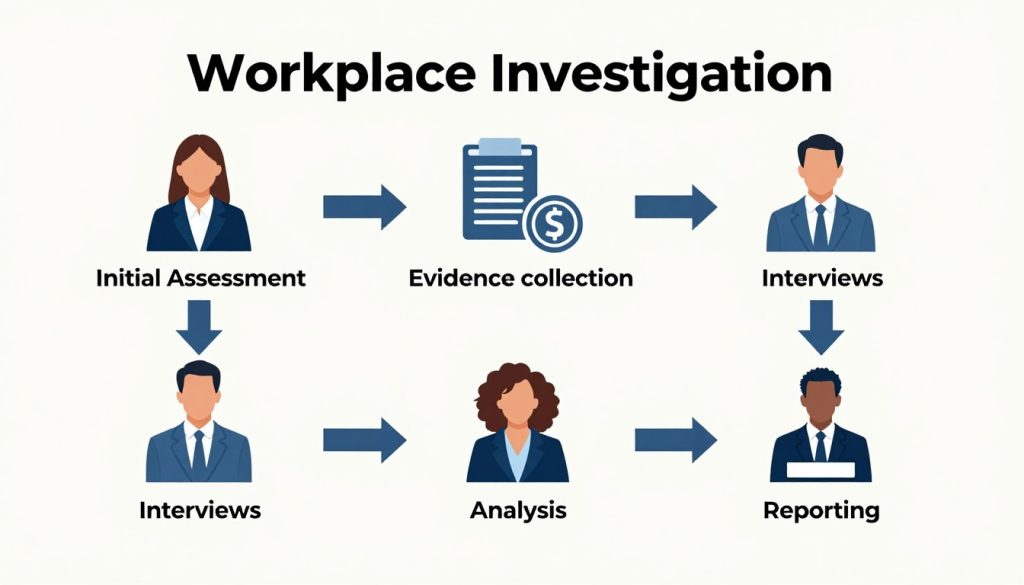blog
In today’s workplace environment, safety extends beyond physical hazards to include psychological wellbeing and protection from harassment, discrimination, and bullying. Understanding the critical connection between bystander intervention and comprehensive workplace safety is essential for Australian organisations committed to creating truly safe environments for all employees.
When workplace incidents occur, the actions taken by both bystanders and management determine whether an organisation’s safety culture truly protects its people. This guide explores how bystander awareness combines with professional investigation to create genuinely safe workplaces.
Commitment to Community Safety
At Jolasers Investigations, we recognise that safe environments—whether at home or at work—start with the courage to speak up.
We acknowledge the significant legacy of community initiatives like the ‘Be There App’ and the MATE Bystander Program, which empowered thousands of Australians to recognise the signs of abuse and coercive control. The philosophy is simple but powerful: we all have a role to play in preventing harm.
These pioneering programs have fundamentally changed how Australians approach safety in their communities. The MATE Bystander Program, developed in Queensland, has trained over 50,000 Australians to recognise concerning behaviours and take appropriate action. Similarly, the ‘Be There App’ has provided accessible tools for identifying warning signs of abuse and responding effectively.
The core principle behind these initiatives is that safety is a collective responsibility. When individuals are equipped with the knowledge to recognise problematic behaviours and the confidence to intervene appropriately, entire communities become safer. This approach has proven particularly effective in addressing issues that historically remained hidden behind closed doors.
Today, Jolasers carries that commitment forward into the corporate sector. We believe that identifying the signs is only the first step. To truly protect your people, allegations of misconduct must be met with rigorous, independent, and procedural investigation.
The Link Between Coercive Control & Workplace Safety
In recent years, the understanding of “safety” has evolved. Just as coercive control is now recognised as a severe form of domestic violence, similar behaviours are increasingly identified as Psychosocial Hazards in the workplace.
Under Australia’s Work Health and Safety laws, employers have a legal obligation to identify and mitigate psychosocial hazards. This includes addressing behaviours that may constitute harassment, bullying, or coercive control in the workplace environment.
The “red flags” that bystanders are trained to spot in personal relationships often mirror the early warning signs of workplace misconduct:
Isolation
Deliberately cutting a colleague off from information or social support. This may manifest as excluding someone from important meetings, withholding critical information needed to perform their job effectively, or socially ostracising them from team activities and communications.
Intimidation
Subtle threats or aggressive non-verbal behaviour. In workplace settings, this could include standing over someone while they work, invading personal space, using threatening body language, or creating an atmosphere where employees feel afraid to speak up or make mistakes.
Control
Excessive monitoring of work, breaks, or movements. This behaviour might involve unreasonable scrutiny of working hours, bathroom breaks, or personal time. It can also include micromanagement that goes beyond reasonable supervision and becomes controlling of every aspect of how work is performed.
Gaslighting
Denying events occurred or making a victim question their reality. In workplace contexts, this might involve a manager or colleague claiming conversations never happened, denying promises were made, or suggesting the victim is “too sensitive” or “imagining things” when they raise legitimate concerns.
When a bystander in your organisation raises a flag, you need to know exactly what is happening. That is where we step in.
Bystander Intervention in the Workplace
Effective bystander intervention is a crucial component of workplace safety. When employees are empowered to recognise and respond to concerning behaviours, they become the first line of defence against workplace misconduct.
The 5Ds of Bystander Intervention
Workplace safety experts have identified five effective strategies for bystander intervention, known as the 5Ds:
- Distract – Create a diversion to interrupt harassment without direct confrontation. This might involve asking an unrelated question, spilling something, or creating a commotion that shifts attention away from the situation.
- Delegate – Seek help from someone in a position of authority or with specialised training. This could include HR representatives, managers, or security personnel who may be better positioned to address the situation.
- Document – Record details of concerning incidents including dates, times, locations, and specific behaviours observed. This documentation can be crucial for establishing patterns of behaviour.
- Delay – Check in with the affected person after an incident to offer support, validate their experience, and let them know you witnessed what happened and are available to help.
- Direct – Address the concerning behaviour directly if it’s safe to do so. This involves clearly stating that the behaviour is inappropriate and must stop.
While bystander intervention is valuable, it’s important to recognise its limitations. Intervention alone cannot address systemic issues or provide the formal resolution needed for serious misconduct. This is where professional investigation becomes essential.
Our Investigative Services

We provide the factual clarity organisations need to resolve complex interpersonal disputes. We transition the focus from “awareness” to “accountability.”
Sexual Harassment Investigations
We investigate allegations of unwelcome sexual conduct, ensuring a trauma-informed approach that respects all parties while establishing the facts on the balance of probabilities.
Our investigations comply with the Sex Discrimination Act and relevant workplace legislation, providing organisations with defensible findings and recommendations. We understand the sensitive nature of these investigations and maintain strict confidentiality throughout the process.

Workplace Bullying & Coercive Behaviour
We examine patterns of unreasonable behaviour that create a risk to health and safety, distinguishing between reasonable management action and genuine bullying or control.
Our investigations consider the full context of workplace interactions, including power dynamics, historical patterns, and organisational culture. We provide clear findings based on the Fair Work Act definition of bullying and applicable Work Health and Safety legislation.

Dispute Resolution & Mediation
Sometimes, early intervention is the best cure. We facilitate structured dispute resolution to address conflict before it escalates into a formal grievance.
Our mediation services provide a neutral forum for parties to address concerns, develop mutual understanding, and reach sustainable agreements. This approach can preserve working relationships while addressing legitimate concerns about workplace conduct.

Local Expertise, Statewide Reach
Workplace safety issues require a swift, on-the-ground response. While we support organisations nationally, our core investigative teams are deeply embedded in the Victorian landscape.
Melbourne Workplace Investigations: We provide rapid deployment for corporate and industrial clients across the Greater Melbourne metropolitan area, ensuring sensitive matters are handled with discretion and local legal compliance.
Geelong Workplace Investigations: Our dedicated regional team supports Geelong and the Surf Coast, understanding the unique industrial and commercial dynamics of the region.
Why Independent Investigation Matters
Encouraging a “Speak Up” culture is dangerous if you don’t have a safe process to handle what comes out.
The Limitations of Internal Reviews
Internal reviews can often be clouded by bias or office politics. When investigations are conducted by managers or HR personnel who have existing relationships with the parties involved, perceptions of bias can undermine the credibility of findings.
Additionally, internal investigators may lack the specialised training and experience needed to conduct thorough, procedurally fair investigations that will withstand legal scrutiny.
Benefits of Independent Investigation
- Impartiality – External investigators have no stake in the outcome and no pre-existing relationships with the parties involved.
- Expertise – Specialist investigators bring dedicated training and experience in workplace investigations.
- Legal compliance – Professional investigators ensure investigations meet all procedural fairness requirements.
- Confidentiality – External investigators provide an additional layer of privacy protection.
By engaging Jolasers Investigations, you demonstrate to your staff—and to the safety regulators—that you take their safety seriously. We provide an unbiased, evidentiary basis for your decision-making.
Our Investigation Process

When you engage Jolasers Investigations, we follow a rigorous, transparent process designed to ensure procedural fairness and deliver clear, actionable findings.
1. Initial Assessment
We begin by clarifying the scope of the investigation, identifying relevant policies and procedures, and developing an investigation plan. This ensures all parties understand what will be investigated and how the process will unfold.
2. Evidence Collection
We gather all relevant documentation, including emails, messages, policies, and any other records that may shed light on the allegations. This creates a foundation of objective evidence for the investigation.
3. Interviews
We conduct thorough interviews with the complainant, respondent, and any witnesses. These interviews are documented and conducted in a trauma-informed manner that respects the dignity of all participants.
4. Analysis
We carefully analyze all evidence against relevant policies, codes of conduct, and legal standards. This analysis considers the context, patterns of behaviour, and the balance of probabilities standard used in workplace investigations.
5. Reporting
We deliver a comprehensive report outlining our findings, the evidence considered, and recommendations for addressing any substantiated misconduct. This report provides a solid foundation for your decision-making.
Meeting Your Legal Obligations
Australian employers have clear legal obligations to provide safe workplaces free from harassment, discrimination, and bullying. These obligations are established through multiple legal frameworks:
- Work Health and Safety Laws – Require employers to identify and mitigate psychosocial hazards, including harassment and bullying.
- Fair Work Act – Prohibits workplace bullying and provides remedies for affected workers.
- Sex Discrimination Act – Establishes the positive duty to prevent sexual harassment and discrimination.
- Equal Opportunity Legislation – Prohibits discrimination on various protected grounds.
Professional investigations demonstrate your commitment to meeting these obligations and can provide a strong defence if regulatory action or legal claims arise. By engaging independent investigators, you show that you’ve taken reasonable steps to address workplace misconduct.
Don’t Just Watch From the Sidelines
Effective workplace safety requires both bystander intervention and professional investigation. While bystanders play a crucial role in identifying and interrupting concerning behaviours, professional investigators provide the thorough, impartial process needed to resolve serious allegations.
At Jolasers Investigations, we bridge the gap between awareness and accountability, helping Australian organisations create truly safe workplaces where misconduct is properly addressed and all employees are protected.
Don’t just watch from the sidelines. Ensure your workplace is safe, compliant, and accountable.
Ready to strengthen your workplace safety?
Our team of professional investigators is ready to help you address workplace misconduct and create a safer environment for all your employees.
Contact us on 0418 101 164 for a free consultation


































